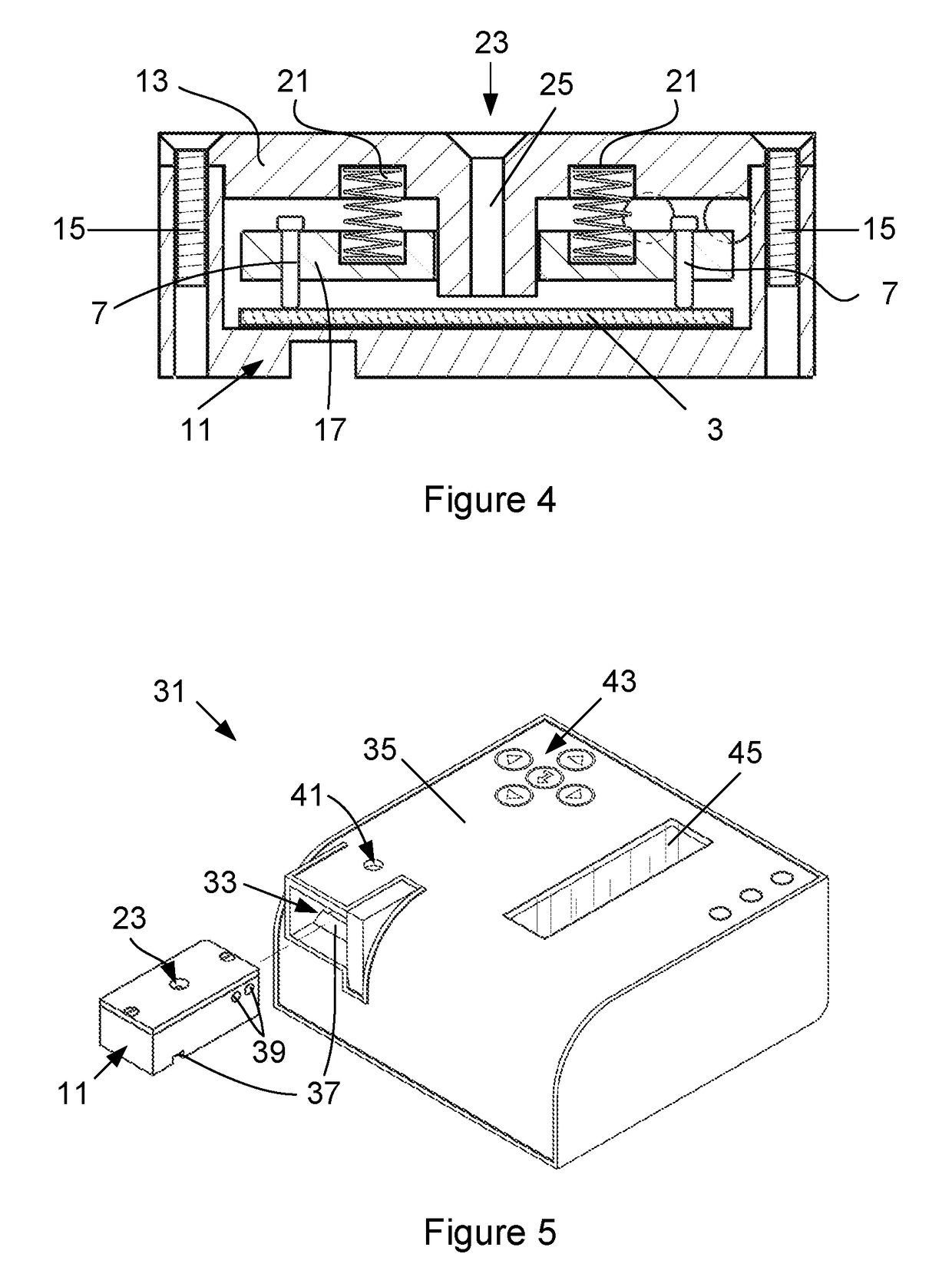Device for detecting target biomolecules
a biomolecule and target technology, applied in the field of target biomolecule detection devices, can solve the problems of reducing the sensitivity of the system, affecting the accuracy of the system,
- Summary
- Abstract
- Description
- Claims
- Application Information
AI Technical Summary
Benefits of technology
Problems solved by technology
Method used
Image
Examples
example 1
[0069]The ability of the device to detect the presence of anti-lysozyme antibody was tested with a membrane on which lysozyme is immobilized as the biological recognition component.
[0070]Methods
[0071]1. Preparation of the Conductive Membrane
[0072]A sheet of nonwoven, spun bound and spot melted polypropylene microfibers with a thickness of 50 g / m2 was cut into a 90×90 mm square sheet. The microfibers of the sheet were provided with a conductive coating comprising doped polypyrrole copolymers. The pyrrole monomer was copolymerized with carboxylic acid functional 3-thiopheneacetic acid (3TAA). A 3TAA solution with a concentration of 10 mg / ml was mixed with 10% pyrrole and the microfiber sheet was submerged in the solution for a few seconds and then removed. Thereafter the microfiber sheet was placed in a glass reaction vessel containing 30 ml of 0.1 M iron(III) chloride (FeCl3) in deionised water. A volume of 1 ml of 0.1 M 5-sulfosalicylic acid (5SSA), acting as a dopant, was added for...
example 2
[0134]The ability of the device to detect Escherichia coli (E. coli) bacteria was tested. The conductive membrane was prepared according to the steps in Example 1 above. However, instead of lysozyme, Anti-E. coli antibody ab25823 was immobilized on the membrane.
[0135]Methods
[0136]The immobilization of Anti-E. coli antibody ab25823 onto the membrane was achieved by firstly washing the conductive membrane with 0.01M PBS and drying it for 10 minutes. The membrane was then incubated in 2.5 mM glutaraldehyde for 1 hour at 4° C. Thereafter, the membrane was washed again with 0.01M PBS and dried for 10 minutes. The membrane was incubated in 600 mL Anti-E. coli antibody (6.67 ug / mL) at 37° C. for 1 hour and thereafter washed with 0.01M PBS and dried for 10 minutes. Thereafter 5% BSA Blocker™ was added to the membrane and it was left to react for 1 hour at room temperature. Finally the membrane was washed three times using 0.01M PBS.
[0137]Different concentrations of E. coli solutions of 3.4×...
example 3
[0141]In this example a paper-based conductive membrane was used as part of the device to demonstrate its ability to detect anti-lysozyme antibodies. Lysozyme protein was immobilized on the paper-based conductive membrane and the resistance of the membrane was monitored and recorded. The resistance measurements were processed and demonstrate that the paper-based conductive membrane is capable of resistive sensing of biomolecules.
[0142]Methods
[0143]Whatmann Grade 50 (97 g / m2) and Whatmann Grade 1 (87 g / m2) Filter Papers were chosen and acquired from Sigma Aldrich due to their wet strength. Whatmann Filter Papers (Grades 1,50) were cut into a standard size of 180×280 mm to be used for testing.
[0144]1. Conductive Coating
[0145]The cellulose fibers of the filter paper were made conductive through coating with a doped polypyrrole solution. The 180×280 mm sheets were first immersed in the pyrrole monomer and left to soak for 5 minutes, this ensured that the paper was fully saturated with t...
PUM
 Login to View More
Login to View More Abstract
Description
Claims
Application Information
 Login to View More
Login to View More - R&D
- Intellectual Property
- Life Sciences
- Materials
- Tech Scout
- Unparalleled Data Quality
- Higher Quality Content
- 60% Fewer Hallucinations
Browse by: Latest US Patents, China's latest patents, Technical Efficacy Thesaurus, Application Domain, Technology Topic, Popular Technical Reports.
© 2025 PatSnap. All rights reserved.Legal|Privacy policy|Modern Slavery Act Transparency Statement|Sitemap|About US| Contact US: help@patsnap.com



